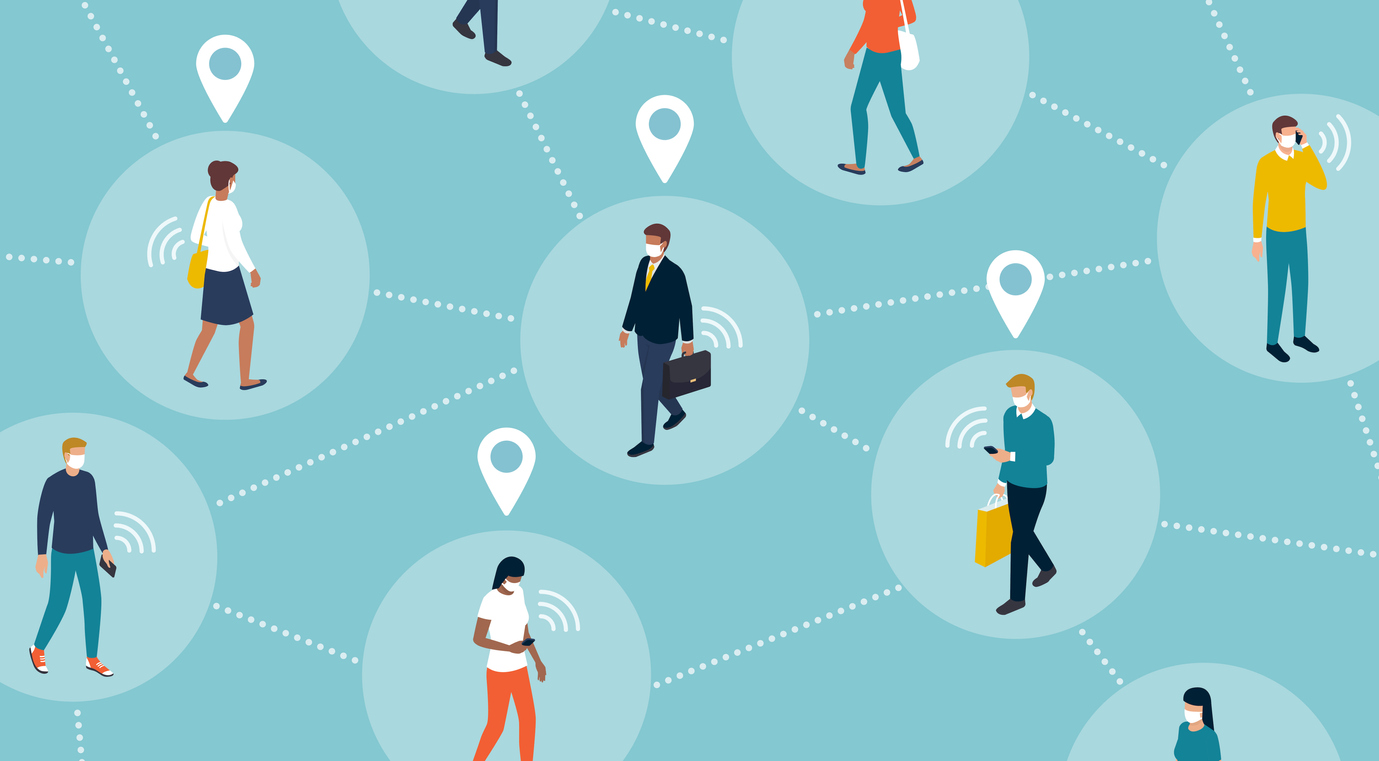
‘We need an army to do this.’ Experts say contact tracing may disrupt COVID-19’s spread
Editor’s note: CHN Intern Olivia Maurer is a junior at Cornell University, where she is majoring in Human Biology, Health, and Society, with a minor in Global Health. Voices for Human Needs is examining the effects of coronavirus on low-income and other vulnerable populations. This post is one in a continuing series.
What is contact tracing and how can it be used to interrupt COVID-19’s deadly path around the world? Imagine going about your daily life with bright red paint on your hands. Everything and everyone you come into contact with is affected. If you brush against someone in the supermarket, they might get a little bit of paint on themselves. They might bring it home to their own family, who could then spread it even further. The exponential nature of viral transmission presents an important barrier to the global effort to “flatten the curve.” Contact tracing might just be the solution.
Contact tracing has the potential to interrupt COVID-19’s chain of transmission by identifying those who are infected, and then locating and notifying their recent contacts. It is estimated that a single person with COVID-19 can infect up to 2-3 people on average. Without a strong public health intervention, one infected individual can lead to nearly 60,000 cases after 10 rounds of infections. This is an especially dangerous domino effect.

Contact tracing might be the tool we need to fight this pandemic.
Since COVID-19 has already made its way around the world, medical professionals such as Anita Cicero, JD, Deputy Director of the Center for Health Security at the Johns Hopkins Bloomberg School of Public Health, urge the nation to take a grassroots approach that bolsters local and state public health agencies in order to achieve the widest scope of testing and treatment. Cicero recently helped develop a national plan alongside the Association of State and Territorial Health Officials that addresses the need for a robust system that identifies all COVID-19 cases and traces all close contacts of each identified case.
Halting the transmission of COVID-19 is a tall order. Though testing for COVID-19 is a widely regarded solution, testing simply identifies those currently infected. Cicero and her colleagues argue that it is crucial to trace the close contacts of any patient who tests positive. This ensures that everyone who has been exposed, even those demonstrating no symptoms, can isolate themselves before the virus’s transmission spreads any further. This is impossible without strong public health systems at the state and local levels. However, state and local public health agencies have suffered budget cuts and about 50,000 job losses – a quarter of the workforce – over the past 12 years.
The underfunding of state and local health agencies poses a major threat to the enactment of contact tracing. Without adequate funds, healthcare workers cannot be interviewed, hired, prepared, and trained. Such a widespread disease demands an equally expansive response. Cicero points out that “we need an army to do this,” referring to the implementation of contact tracing and other comprehensive, detailed epidemiological measures.
Cicero also points out the unique challenges that accompany contact tracing in vulnerable populations. “[We need] to really think through how you would care for people who are in vulnerable housing or group housing situations,” she says. “It might not be that everyone can safely quarantine at home, and I think we would need to have other safe, clean, attractive places for people to even voluntarily go to during their two weeks of quarantine, and to provide the resources they need to make that possible.”
The scope of contact tracing is anything but narrow. An epidemiologist, or a “disease detective,” starts with the index patient, commonly referred to as “patient zero.” They interview the patient, learning more about their daily life and identifying all close contacts. This may include information about the patient’s travel history, as well as where they have eaten, slept, or even bathed. The epidemiologist will then contact the management of airlines, restaurants, hotels, and shopping centers where the index patient may have come into contact with others. This creates an enormous amount of outreach and communication – for just one patient. Contacts add up quickly, especially when considering a highly infectious virus like COVID-19. As the number of potential contacts increases, so does the amount of work needed to reach them all.
“Even if there’s a widespread epidemic where you don’t know your transmission chain, contact tracing still adds value,” says Ranu Dhillon, an instructor and physician in the Division of Global Health Equity at the Brigham and Women’s Hospital in Boston. Massachusetts has already launched an initiative in partnership with Partners in Health, a local nonprofit organization, to initiate contact tracing. The intervention has reached 765 residents who have tested positive for COVID-19, who have then identified more than a thousand close contacts to be interviewed by contact tracers.
Receptivity has been a major challenge, according to John Welch, director of partnerships and operations for the MA Covid Response project at Partners in Health. Welch reports that many contacts don’t pick up their calls, most commonly assuming spam. The project’s tagline has become “Help us help you. To stop COVID in Massachusetts, answer this call.”
Massachusetts has worked with major telecom companies in order for the contact tracers’ calls to go through. They have secured specific prefixes for their contact tracing calls, as well as an informative caller ID: “MA COVID Team.” However, not every recipient pays for caller ID. As a result, the team is currently urging Sprint, Verizon, and other major telephone companies to waive caller ID fees to make the effort more accessible.
Locating and notifying each COVID-19 patient’s close contacts seems like a simple solution. However, one must account not only for the workers that need to be hired, trained, and paid, but also how to contact such a large volume of people, not all of whom have phone service. Kerry Robarge, a Massachusetts-based contact tracer, says that she is “immersed in the pandemic with every call.”
“When we reach out we find people in crowded living conditions or find large numbers of people in organizations who have all tested positive,” Robarge says. “We’re talking to people who are very scared.” State and local health organizations deserve the funding that they need to keep up with COVID-19. The virus has had a tangible strain on the nation’s mental health as well as its physical health.
The number of confirmed coronavirus cases in Massachusetts has increased by 1,924 people every day, on average, and contact tracers are faced with a new challenge. How does one offer the compassion and sympathy necessary to tell someone they may have contracted the coronavirus? An even larger challenge: how do you do this for nearly 2,000 people each day?
“I do worry about a surge,” says Welch, “[and] making sure that we’re hiring the right numbers of people and that they’re able to be productive on the phone while still being a compassionate, sympathetic ear.”
Dr. Mike Reid, an assistant professor in infectious disease at the University of California, San Francisco, reports that contact tracing calls often last an hour or longer. Once the shelter-in-place order begins to be eased, Reid says, the city of San Francisco alone will need up to 150 people or more just to work the phones.

It is evident that contact tracing must be expanded in a similar fashion across the entire U.S. Public health experts at Johns Hopkins recommend an additional 100,000 contact tracers be hired and trained to expand the effort to contain COVID-19; others have suggested as many as 300,000. This case-based intervention has the potential to lessen the strict social distancing measures that have defined America’s past month. However, it requires a monumental scaling-up of the local and state public health workforce. This initiative also represents the opportunity for employment for those who may have lost their incomes as a result of the pandemic.
Now is the time for Congress, the Trump Administration, and the country to come together to properly fund and implement large-scale contact tracing. This can only be accomplished through an unprecedented and rapid increase in support of the public health workforce via state and local health agencies. Federal funding for public health preparedness is simply not adequate to handle the coronavirus in its current state. A commitment to these invaluable public health systems is a commitment to slowing and stopping the spread of COVID-19.

